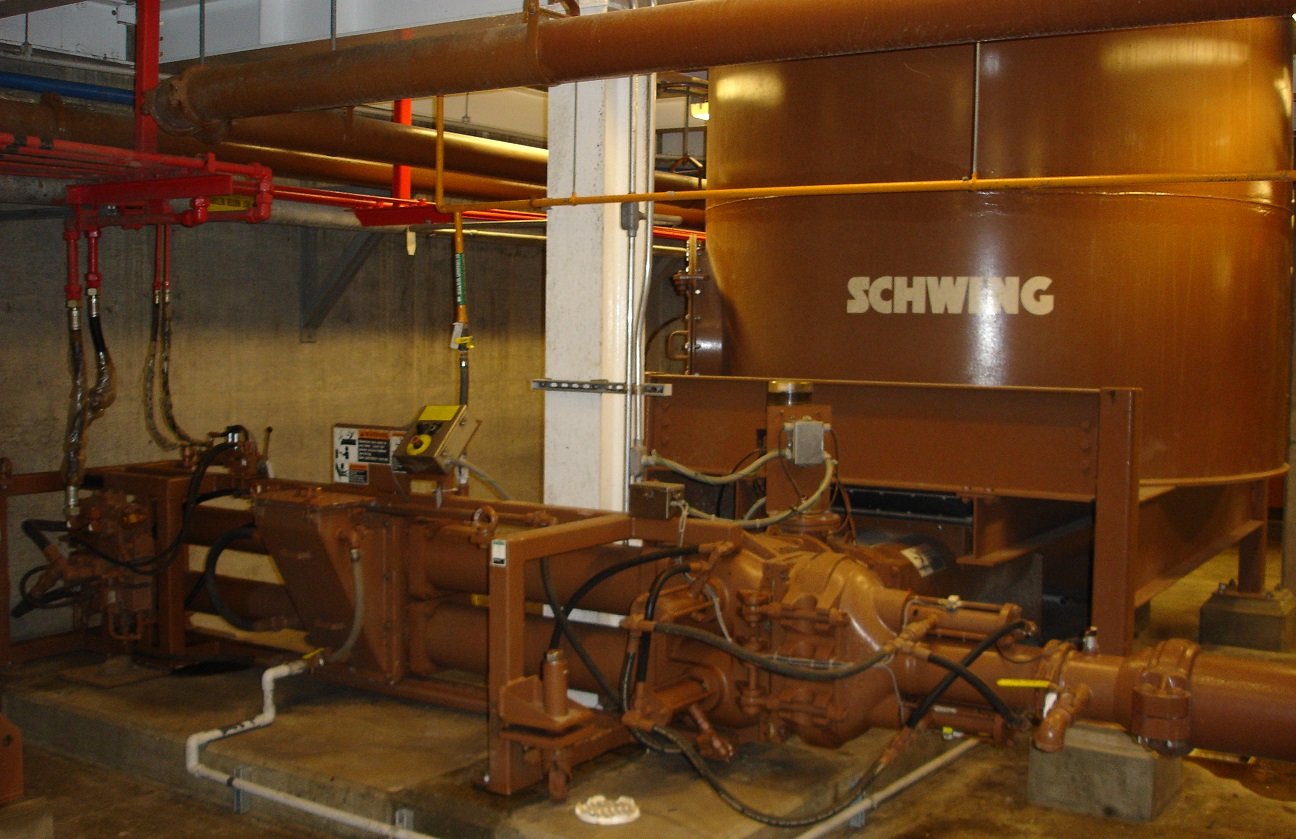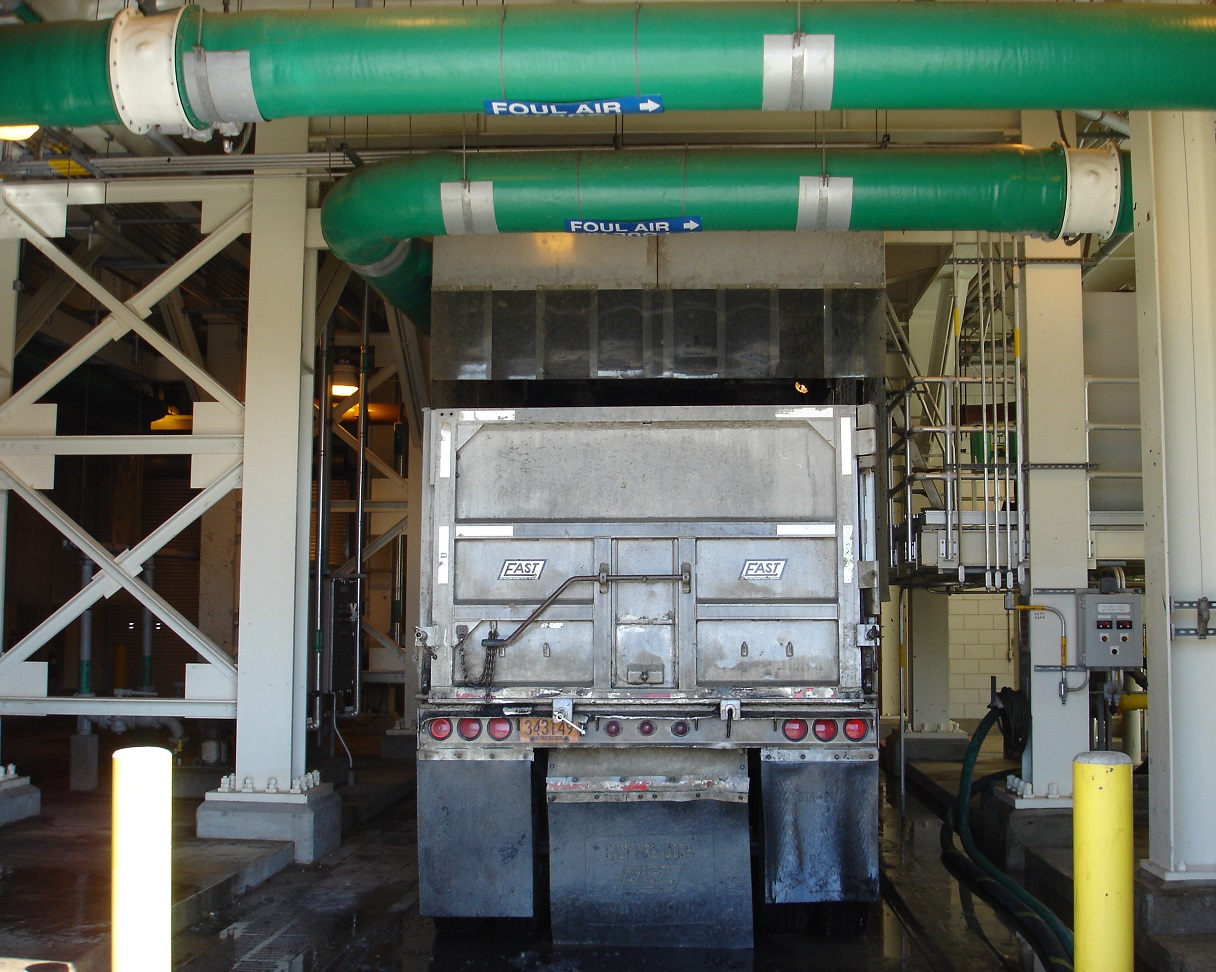Schwing Bioset Application Report 14, Columbus, Ohio
Written by Larry Trojak, Trojak Communications
Version also published in WE&T Magazine
Pumps and sliding frames allow options for effective disposal of cake from Columbus, Ohio, operation.
Wastewater treatment plants can distinguish themselves in any number of ways: by the volumes they can handle, by the number of industry awards they have earned, by the manner in which they handle an interruption in “business-as-usual”, and so on. They can also do so by demonstrating a creative, effective and successful effort to use or dispose of the biosolids they generate. Given those criteria alone, the Southerly Wastewater Treatment Plant could likely be seen as one of the premier WWTPs in operation today. Just coming off a five-year, $350 million expansion which nearly tripled its peak capacity from 114 mgd to about 330 mgd (built-in contingencies for further expansion can take the plant as high as 550 mgd), the plant services the majority of the greater Columbus area. State-of-the-art in every regard, Southerly is poised to build upon an already impressive reputation that has won them numerous National Association of Clean Water Agencies (NACWA) awards for plant and employee performance.

But it is also its innovative sludge disposal program that separates Southerly from super-plant wannabes. Using a quartet of heavy-duty pumps and a number of sliding frame components (all from Schwing Bioset, Inc. [SBI] Somerset, WI) cake can either be routed directly for incineration or sent to a pair of storage silos. Once in the silos, the material is readily available for truck-loading and transport, either to an already-successful composting operation run by the department or directly to the landfill. Options, it seems, are the hallmark of this successful operation.
Change They Can Use
Built in 1967, the Southerly WWTP is one of two plants serving the Columbus metropolitan area (the other being the nearby Jackson Pike WWTP). The current plant expansion which so dramatically increased overall capacity, also increased volumes in the solids handling area. New centrifuges, installed a number of years in advance of that expansion, handle that increase nicely, according to Jeff Hall, Assistant Plant Manager.
“That upgrade was implemented both to replace aging equipment, as in the case of the centrifuges, and to add functionality to other areas like the transportation of solids,” he says. In the past, primary solids were gravity thickened while older centrifuges thickened the waste activated sludge (WAS). The new units now thicken both the primary solids and the WAS. This new approach boosts the solids content of the resulting dewatered cake to about 20-25%, a nice improvement over the 17-21% solids content with the older system.”
Additional changes brought about in that initial upgrade included installation of new cake pumps, a pair of storage silos, and sliding frames at two points in the solids handling process.

The Route To Disposal
Getting cake to the point where disposal options are available is a function of Southerly’s pumps and silos. As material exits the centrifuges, it is routed to any of four Schwing KSP 45V(HD)L-SFMS pumps which direct it to the appropriate area. Where that is, varies greatly according to need.
“Even though incineration is the most efficient method of disposal, we still try to keep the compost operation fed with as much as it needs, since that is the better use of the product,” says Carmon “Skip” Allen, Solids Supervisor 2. “Obviously that can vary from day to day. The balance of the material—we can do anywhere from 5.5 tons up to 9 tons an hour—is then sent for incineration. But we know at all times what is going to the silos for storage and what’s getting burned.”
The sludge pumps at Southerly are designed to generate a force sufficient to move cake the long distances needed for either incineration or storage. He says it is easily 300 feet to the multi-hearth incinerators (which have operating temps of 1400°F), and about 400 feet to the storage silos. Equipped with Schwing Bioset’s Sludge Flow Measuring System, the pumps are able to measure to within +/-5% the amount of sludge that is pumped to the incinerator. This simplifies their USEPA reporting requirements for their incinerator operations.
“Material headed to the silos, however, has an additional challenge to overcome,” says Allen. “Once there, the cake has to go straight up another 100 feet to enter the top of the structures, so the force needed to do that is really pretty impressive. I don’t think any regular equipment would be up to a task like that; these are definitely the right pumps for the job.”
Giving it the Slip
Despite maximum operating pressures of 1,100 psi for each pump, those extended distances at Southerly prompted Schwing Bioset to make accommodations to help move the sludge along. To do so, they added a “slip ring,” or pipeline lubrication system. Schwing Bioset’s unique design includes a 360 degree annular groove that evenly injects a thin film of water around the entire annulus of the pipe that separates viscous and sticky materials from the inner wall of the pipeline. The end result is a reduction in friction loss in the pipeline, and lower—in some cases better than 50% less—pipeline operating pressures.
Additional benefits include a savings in energy by reducing the demand on each pump and hydraulic unit, and, because of the reduction in pipeline friction, an increase in wear part life. While other systems try to address the friction issue through the use of as many as four drilled ports which inject more fluid, this offsets a percentage of the gains made by the centrifuges. Still other designs mix polymer with the water to help reduce pressure which, while effective, adds both up-front and perpetual costs to the operation.
Tom Thomas, Maintenance Supervisor 2 at Southerly, says the reduction in friction has also shown benefits in wear part life for the pumps—a fact that is borne out in similar results at Jackson Pike. “We run these pumps round the clock and, even with that 24/7 operation, parts such as the pumping rams, poppet valve discs and seats are getting six months of wear. That’s about 4,000 hours of wear part life, which is outstanding given what they’re being asked to pump.”
Silo Efficiency
As mentioned, the SBI sliding frame silos offer a storage option for cake headed either to the landfill for disposal or to the compost site. Prior to their installation, Southerly relied upon a smaller holding vessel known as “the pit,” a belt-fed, hopper-equipped component that used a series of screws to feed a truck sitting under the discharge chute. City officials say the new silos are larger (providing about 75% more capacity) as well as far more efficient, thereby reducing truck loading times from 45 minutes with “the pit,” down to only five minutes. This was an important criterion when selecting equipment.
Because the City pays a contractor to haul the biosolids, reducing loading times lowers overall hauling costs—the trucks now spend more time hauling and less time waiting to be loaded. The net result is more trucks loaded per day (and a lower cost to do so.) In addition, because of that added storage capability, the composting operation now has the option of drawing material solely from Jackson Pike, if necessary. “Anytime you can reuse something rather than just burying it or burning it, you are making a positive impact,” says Assistant Plant Manager Jeff Hall.
“Today, we are reusing about one-third of the solids we handle through the composting operation,” says Hall. “That’s obviously good from an economic standpoint, since we are generating revenue from a product that was once simply discarded. However, it is also a plus from an environmental perspective.”
The concept of the sliding frame silo is simple, yet very effective. Hydraulic cylinders move an elliptical frame across the silo floor. The frame’s action not only breaks any bridging that can occur over the extraction screw, it also pushes and pulls material towards the silo extraction screws for discharge into trucks.
Allen says the sliding frame silos were a nice addition to the operation. “Each silo holds better than 1,500 tons of cake, so even if one of the incinerators went down and there was an interruption in the trucking operation, we’d still have a nice short-term storage option while things get back up again. It’s really all about flexibility and these silos afford us that.”
Due to the sheer size of the silos, they are each equipped with three extraction screw conveyors at the bottom which allows the trailers to be evenly loaded without having to be jockeyed back and forth.
The silos also include an odor and splash control shroud that pulls fumes directly off the trailer, thereby minimizing the need for odor control in the truck loading building. In addition, it helps reduce the chance of material splatter during load-out, and confines any such instances to the area immediately adjacent to the trailer, which makes periodic cleanup of the area much easier.
Allen adds that they also use SBI sliding frames on hoppers in advance of the pumps which feed the incinerator. Doing so provides a wide spot in the process line enabling them to maintain steady incinerator operations for several hours in the event of any upset condition with the centrifuges.
Sibling Growth
Southerly WWTP’s growth is being mirrored in the expansion of its sister plant, Jackson Pike WWTP, located a mere seven miles from Southerly’s facility. That plant also installed SBI equipment for similar end uses, but because its capacities are less, scaled down the size of that equipment. So today, Jackson Pike uses a quartet of KSP 25 V(HD)L pumps, rather than the 45s in use at Southerly and powers them with a 100hp power pack compared to its 150hp counterpart. The silos, though smaller in height, are of the same design and offer the same performance benefits as Southerly’s. Once the expansion at Jackson Pike is complete, the two plants will effectively meet all of Columbus’s wastewater treatment needs for decades to come. For Skip Allen, seeing construction at Southerly come to an end after nearly six years is a welcome relief.
“We are all really happy about the changes that have taken place here; there’s no doubt about that. But it feels like we will now finally be able to get back into the treatment plant business. With construction done, we have a big headache behind us, we have a great operation in place, and we’re doing good things for the residents of Columbus. That’s not a bad place to be.”

To download the entire #14 application report for Columbus, Ohio, click here.
To learn more about Schwing Bioset, our products and engineering, or this project specifically, please call 715-247-3433, email marketing@schwingbioset.com, view our website, or find us on social media.
Download Our Brochures and Application ReportsSubscribe to Start Receiving Schwing Bioset eNews
